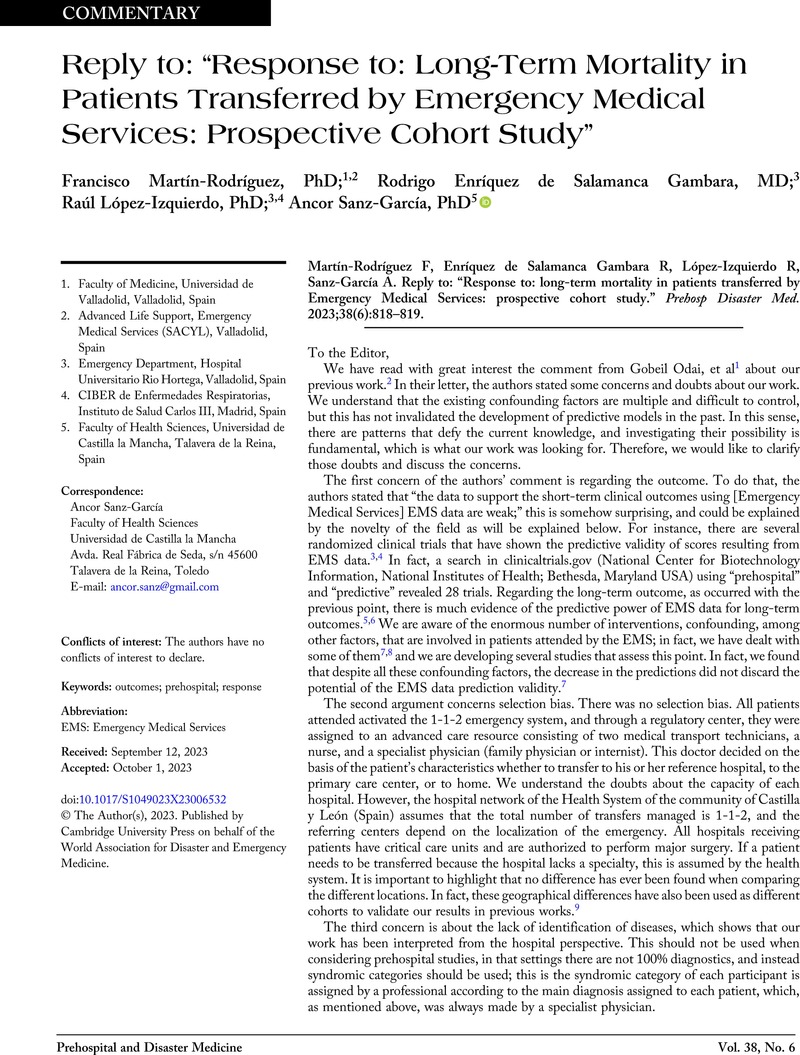No CrossRef data available.
Article contents
Reply to: “Response to: Long-Term Mortality in Patients Transferred by Emergency Medical Services: Prospective Cohort Study”
Published online by Cambridge University Press: 25 October 2023
Abstract
An abstract is not available for this content so a preview has been provided. Please use the Get access link above for information on how to access this content.

Keywords
- Type
- Article Commentary
- Information
- Copyright
- © The Author(s), 2023. Published by Cambridge University Press on behalf of the World Association for Disaster and Emergency Medicine
References
Gobeil Odai, K, Seulami, N, Alhefeit, S, Almehairi, N, Gangatharan, H, Wang, J. Response to: long-term mortality in patients transferred by Emergency Medical Services: prospective cohort study. Prehosp Disaster Med. 2023;38(5):687–688.10.1017/S1049023X2300626XCrossRefGoogle ScholarPubMed
Enriquez de Salamanca Gambara, R, Sanz-García, A, Martín-Conty, JL, et al. Long-term mortality in patients transferred by Emergency Medical Services: prospective cohort study. Prehosp Disaster Med. 2023;38(3):352–359.10.1017/S1049023X23005800CrossRefGoogle ScholarPubMed
Scott, IM, Manoczki, C, Swain, AH, et al. Prehospital telestroke vs paramedic scores to accurately identify stroke reperfusion candidates: a cluster randomized controlled trial. Neurology. 2022;99(19):e2125–e2136.10.1212/WNL.0000000000201104CrossRefGoogle ScholarPubMed
Jousi, M, Reitala, J, Lund, V, Katila, A, Leppäniemi, A. The role of pre-hospital blood gas analysis in trauma resuscitation. World J Emerg Surg. 2010;5:10.10.1186/1749-7922-5-10CrossRefGoogle ScholarPubMed
Pemberton, K, Franklin, RC, Bosley, E, Watt, K. Prehospital predictors of long-term survival from out-of-hospital cardiac arrest. Australas Emerg Care. 2023;26(2):184–192.10.1016/j.auec.2022.10.006CrossRefGoogle ScholarPubMed
Lahmann, AL, Bongiovanni, D, Berkefeld, A, et al. Predicting factors for long-term survival in patients with out-of-hospital cardiac arrest - a propensity score-matched analysis. PLoS One. 2020;15(1):e0218634.CrossRefGoogle ScholarPubMed
Martín-Rodríguez, F, Sanz-García, A, Martínez Fernández, FT, et al. Association between prehospital lactate categories with short- and long-term mortality. A prospective, observational multicenter study. QJM. 2023:hcad167.10.1093/qjmed/hcad167CrossRefGoogle Scholar
Martín-Rodríguez, F, Enriquez de Salamanca Gambara, R, Sanz-García, A, et al. Comparison of seven prehospital early warning scores to predict long-term mortality: a prospective, multicenter, ambulance-based study. Eur J Emerg Med. 2023;30(3):193–201.10.1097/MEJ.0000000000001019CrossRefGoogle ScholarPubMed
Martín-Rodríguez, F, Sanz-García, A, Alberdi Iglesias, A, et al. Mortality risk model for patients with suspected COVID-19 based on information available from an emergency dispatch center. Emergencias. 2021;33(4):265–272.Google ScholarPubMed



